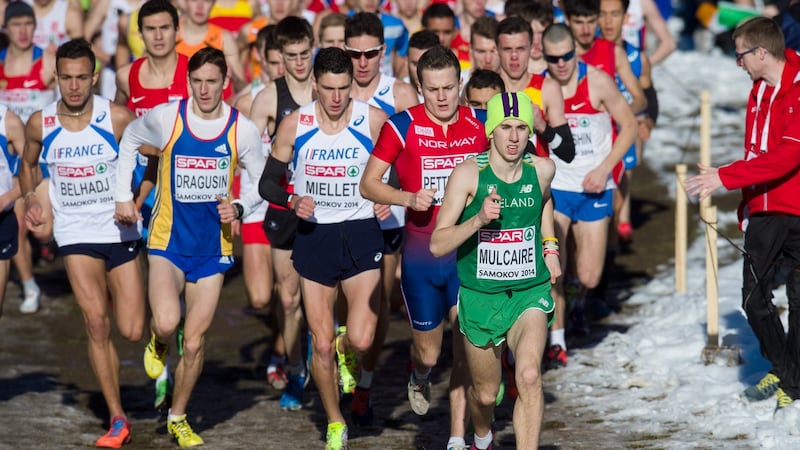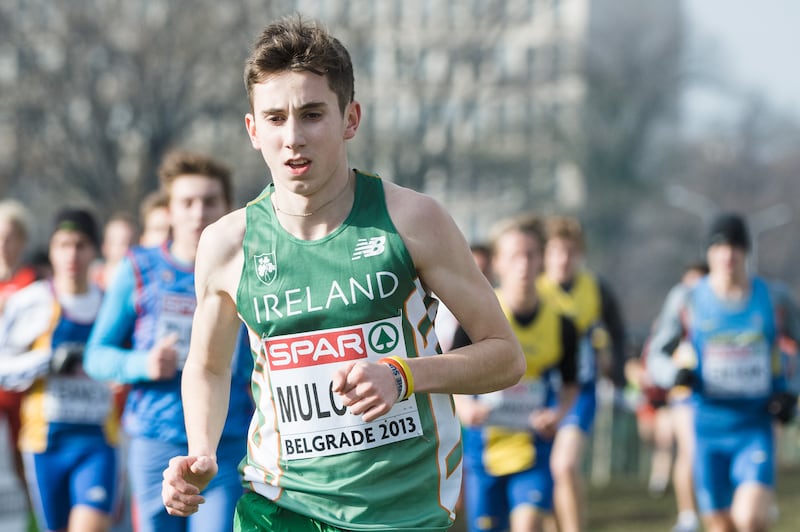‘If we have a fitter, leaner, stronger schoolboy athlete than Kevin Mulcaire right now then he’s hiding out somewhere. No one could touch Mulcaire at Sligo racecourse on Saturday, his runaway victory in the senior boys’ event quite possibly the most impressive in the history of these championships.
‘That is saying something: this year marks the centenary of Irish Schools Athletics, many athletes going on to great things after winning this title, and yet Mulcaire’s performance was utterly consummate and entirely without flaw’.
The Irish Times Sport, March 6th, 2016
In the almost eight years since these gentle words of praise were written by this correspondent it’s as if Kevin Mulcaire has been hiding out. At times it seemed his chances of reappearing were gone, but it turns out he’s not been forgotten.
READ MORE
After running that day in the colours of St Flannan’s in Ennis, winning a fourth successive Schools title, Mulcaire didn’t run another cross-country race in Ireland until last month. For most of the last eight years, it seems that if it wasn’t for bad luck, he’d have had no luck at all.
By chance, that latest race coincided with his first visit home since the summer of 2018, after Mulcaire followed the US scholarship trail to Oklahoma State University, then to the University of New Mexico in Albuquerque.
Also reconnecting with his running coach Pat Hogan, at Ennis Track Club, he lined up for the National Cross-Country in Kilkenny on November 19th “mainly for fun”. Instead he finished second to Cormac Dalton, securing his place on the Irish team for Sunday’s European Cross-Country Championships in Brussels.
That comes exactly eight years since his last appearance in an Irish vest, in the under-20 race at the 2015 event in Hyères, France.
“I remember that year, after not running great at Euro Cross, I gave the classic speech of ‘I’ll be back next year’”, he says. “In reality, it took another eight years. So I am definitely not taking this one for granted.”
When Mulcaire first left for Oklahoma at 19, he was evidently our most talented junior men’s distance runner since John Treacy. In May 2015, he ran 14:02.30 for 5,000m on the track, breaking the Irish under-20 record, which had stood to Treacy for 40 years.
Last March in Stanford, Mulcaire finally improved on it, running 13:42.99.
“I’m too dumb to know when to quit. That’s what I always say.”
The story of his repeated cycle of injury is not unique, nor is the one about how his journey to the US, instead of progressing his promising running career, came perilously close to marking the end. Still, it’s a timely reminder that while such obstacles and challenges will always come and go, talent always remains.
When we last spoke, Mulcaire was just settling in at Oklahoma State, under head coach Dave Smith, having travelled out midsemester in January 2017. He wasn’t quite back to full running fitness after sustaining a stress fracture in his foot just weeks after that schoolboy race in Sligo.
The university is in Stillwater, the town where Oklahoma began and which now has a population of about 48,000, roughly half of them students. About 95km northeast of Oklahoma City, in the old prairie country, it’s an area popularly known as Tornado Alley, and also celebrated as the home of the National Wrestling Hall of Fame and the Tumbleweed Dance Hall, where Garth Brooks got his start.
“When I think back on it, now, it’s almost like I’ve lived two lives,” he says. “The Oklahoma running life was just injury after injury.
“I got over my foot thing, then I somehow managed to tear my meniscus in both my knees, which cost me the best part of a year. My knee would lock, my leg would completely stiffen, I couldn’t even bend it. And I’d be on crutches again for a few weeks.
“Then I got a femoral neck fracture, which cost me a lot of time. Then I had a groin tear. I had Achilles issues. It just seemed to be one thing after the next.
“But while it wasn’t a great time for my running, I am so grateful for Oklahoma State. People ask me would I go again, and I don’t know if I could have gone to a better programme to be injured at. Dave Smith could have kicked me off the team so many times. Like, I went into his office so many times and just cried, ‘let me off this team ... I just suck’. It didn’t feel right taking a full scholarship, I told him I’d happily sign medical hardship and he could pawn me off.
“But he just kept saying ‘no, let’s sit it out for one more year, maybe things will come together for you’. The team at that point was so incredibly strong, and I felt I needed to take a step back from trying to be good first, and just try to be durable.”

At one point, Mulcaire attended a specialist running doctor in Arizona, costing around $15,000, which at least did get him back running: “And Dave Smith had no problem paying that. And this was someone who hadn’t ran for him in three years. So I look back on all that with so much gratitude. You ask about me ever quitting, I think the people around me stopped me from ever doing that, there were just too many motivational, supportive people around me.”
Mulcaire did repay some of that faith, at the delayed NCAA Cross-Country in March 2021, when he was part of the Oklahoma team that finished third overall. “I ran for them in one track season, and one cross-country season, in my entire five years.”
After graduating with a BA in Biology, he transferred to the University of New Mexico, completing an MA in Data Analytics, with another 1½ years of NCAA eligibility.
When that journey finished in May, he continued to work with former New Mexico assistant coach Annie Richards, as well as Hogan in Clare, though still unsure what the next chapter might be; not least when he got an email from US Immigration telling him he’d 60 days to leave the country unless he got his OPT visa.
“After running the 13:42 in March, I thought maybe there is some running left in me, before I fell apart again. So after finishing at New Mexico, I spent the summer building fences, kind of in limbo again, waiting on my OPT visa, so I could work here. My parents [Catherina and Brendan], especially in the last few years, have also been very supportive, but I really thought I was done with running.”
With his visa secured, his return also came thanks to a newly accommodating employer in the Office of Institutional Analytics (OIA) in Albuquerque, who allowed him to work remotely so he could travel home for the first time since 2018 (Covid-19 being the main obstacle there).
“Actually I haven’t been injured that much in the last two years. I’ve just been slow. Half of that was my fault, maybe all of it. I just wasn’t paying enough attention to what I was doing. I thought I was doing 80-mile weeks, but when I really look back, they weren’t.
“So the main reason to come home was to see my family, who I hadn’t seen for five years. Running the Nationals was really last minute. I’d joked with Pat a few times that I might run it, but I hadn’t run a race since May, where I ran horribly slow.

“I had a suspicion I might have some fitness, living at altitude for a while [Albuquerque is at 5,000ft]. And the last few months I got up to 90-mile weeks, kind of fell in love with the process again, rather than seeking out results.
“But all through the race I was waiting for everyone to fly by, then at 2km to go, I thought ‘hold on, I might make the top five’. So until I got to the home stretch, and I was very content with second, I didn’t think I’d be even in the same race as them.”
He unquestionably was, his reappearance in Kilkenny in many other ways completing the journey back from that day at Sligo racecourse.
“It’s almost like it had to happen, that maybe I had it too easy, didn’t have any real adversity or challenges as a junior. I had a bit of an ego, and struggled when I wasn’t at the front of races. So maybe this all had to happen to become the athlete I want to be. Like, to never throw in the towel, whether I’m first or 50th, and being healthy but slow for the last year was really humbling. You learn to give it your best in a different way.
“I still don’t enjoy being slow, being at the back of the race, so that’s the driving factor now. I do have other responsibilities in my life now, with my work, but I’d love to run fast times again, would obviously love to run the Olympic standard.
“Right now I am running pain free. I’ve ramped up the intensity, but also being more intentional about what I do. Maybe I’ve prolonged my career, because I basically didn’t run for five years in the middle of it. Hopefully I’ll get some of those five years back at the other end.”
- Sign up for push alerts and have the best news, analysis and comment delivered directly to your phone
- Find The Irish Times on WhatsApp and stay up to date
- Our In The News podcast is now published daily – Find the latest episode here













